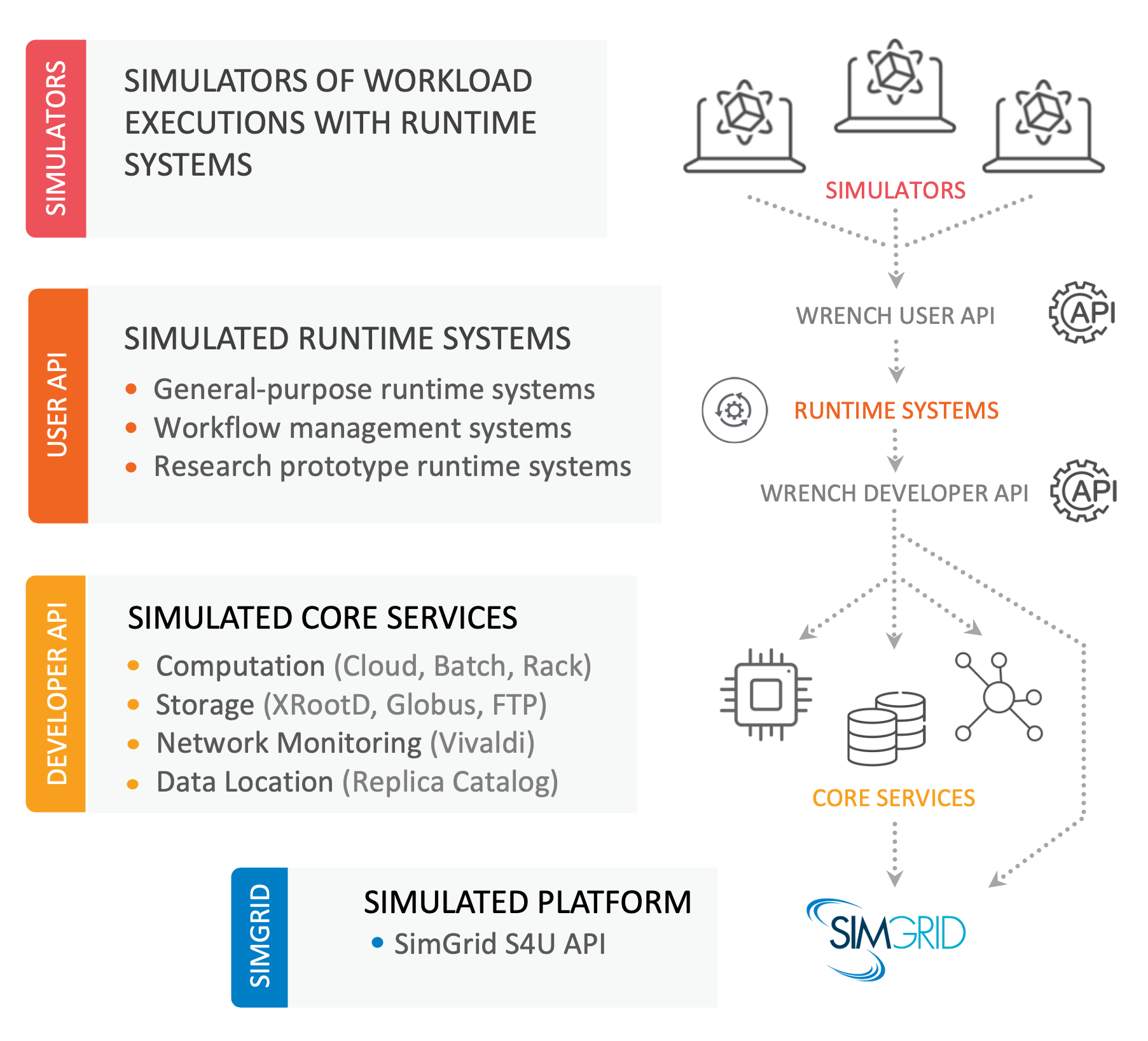
WRENCH is an open-source framework designed to make it easy for users to develop accurate and scalable simulators of distributed computing applications, systems, and platforms. It has been used for research, development, and education. WRENCH capitalizes on recent and critical advances in the state of the art of simulation of distributed computing scenarios. Specifically, WRENCH builds on top of the open-source SimGrid simulation framework. SimGrid enables the simulation of distributed computing scenarios in a way that is accurate (via validated simulation models), scalable (low ratio of simulation time to simulated time, ability to run large simulations on a single computer with low compute, memory, and energy footprints), and expressive (ability to simulate arbitrary platform, application, and execution scenarios). WRENCH provides directly usable high-level simulation abstractions, which all use SimGrid as a foundation, to make it possible to implement simulators of complex scenarios with minimal development effort.
In a nutshell, WRENCH makes it possible to:
Develop in-simulation implementations of runtime systems that execute application workloads on distributed hardware platforms managed by various software services commonly known as Cyberinfrastructure (CI) services.
Quickly, scalably, and accurately simulate arbitrary application and platform scenarios for these runtime system implementation.
Architecture
WRENCH is an open-source C++ library for developing simulators. It is neither a graphical interface nor a stand-alone simulator. WRENCH exposes several high-level simulation abstractions to provide high-level building blocks for developing custom simulators.
WRENCH comprises four distinct layers:
Top-Level Simulation: A top-level set of abstractions to instantiate a simulator that simulates the execution of a runtime system that executes some application workload on some distributed hardware platform whose resources are accessible via various services.
Simulated Execution Controller: An in-simulation implementation of a runtime system designed to execute some application workload.
Simulated Core Services: Abstractions for simulated cyberinfrastructure (CI) components that can be used by the runtime system to execute application workloads (compute services, storage services, network proximity services, data location services, etc.).
Simulation Core: All necessary simulation models and base abstractions (computing, communicating, storing), provided by SimGrid.

Three Classes of Users
On can distinguish three kinds of WRENCH users:
Runtime System Users use WRENCH to simulate application workload executions using an already available, in-simulation implementation of a runtime system that uses Core Services to execution that workload.
Runtime System Developers/Researchers use WRENCH to prototype and evaluate runtime system designs and/or to investigate and evaluate novel algorithms to be implemented in a runtime system.
Internal Developers contribute to the WRENCH code, typically by implementing new Core Services.
Three Levels of API Documentation
The WRENCH library provides three incremental levels of documentation, each targeting an API level:
User: This level targets users who want to use WRENCH for simulating the execution of application workloads using already implemented runtime systems. Users are NOT expected to develop new simulation abstractions or algorithms. Instead, they only use available simulation components as high-level building blocks to quickly build simulators. These simulators can involve as few as a 50-line of C++ code.
Developer: This level targets runtime system developers and researchers who work on developing novel runtime system designs and algorithms. In addition to documentation for all simulation components provided at the User level, the Developer documentation includes detailed documentation for interacting with simulated Core Services. There are two Developer APIs. The most generic API is called the Action API, and allows developers to describe and execution application workloads that consist of arbitrary “actions”. The Workflow API is specifically designed for those developers that implement workflow runtime systems (also known as Workflow Management Systems, or WMSs), and as such is provides a Workflow abstraction that these developers will find convenient. All details are provided in the rest of the documentation.
Internal: This level targets those users who want to contribute code to WRENCH. It provides, in addition to both levels above, detailed documentation for all WRENCH classes including binders to SimGrid. This is the API needed to, for instance, implement new Core Services.
Get in Touch
The main channel to reach the WRENCH team is via the support email: support@wrench-project.org.